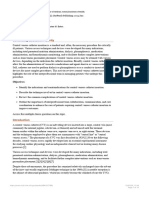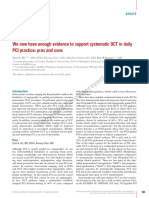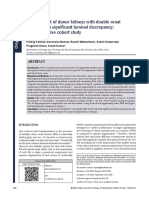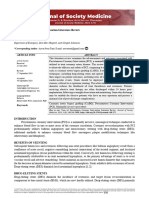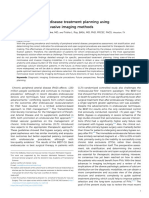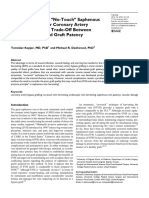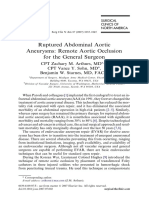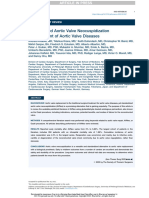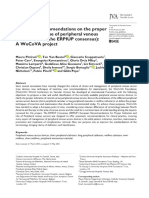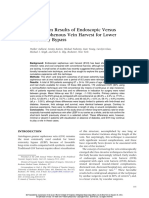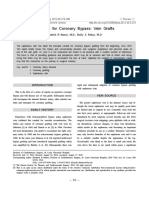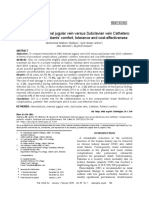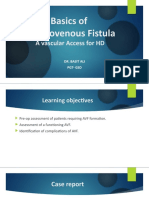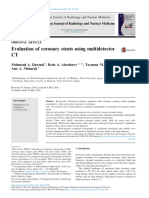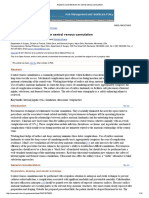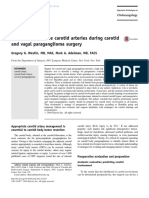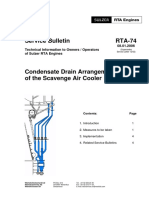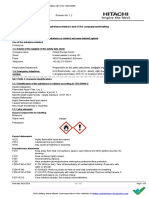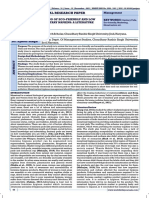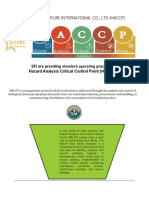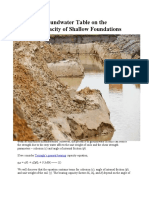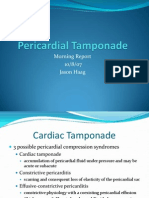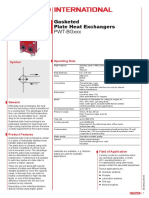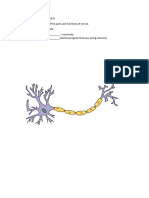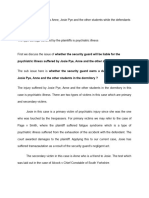Vascular Closure Device in Cardiac Cath Laboratory: A Retrospective Observational Study
Vascular Closure Device in Cardiac Cath Laboratory: A Retrospective Observational Study
Uploaded by
patelCopyright:
Available Formats
Vascular Closure Device in Cardiac Cath Laboratory: A Retrospective Observational Study
Vascular Closure Device in Cardiac Cath Laboratory: A Retrospective Observational Study
Uploaded by
patelOriginal Title
Copyright
Available Formats
Share this document
Did you find this document useful?
Is this content inappropriate?
Copyright:
Available Formats
Vascular Closure Device in Cardiac Cath Laboratory: A Retrospective Observational Study
Vascular Closure Device in Cardiac Cath Laboratory: A Retrospective Observational Study
Uploaded by
patelCopyright:
Available Formats
[Downloaded free from http://www.marinemedicalsociety.in on Thursday, March 28, 2019, IP: 43.250.165.
189]
Original Article
Vascular Closure Device in Cardiac Cath Laboratory:
A Retrospective Observational Study
Surg R Adm Ravi Kalra, NM, VSM1, Surg Capt R. Ananthakrishnan1, Surg Cdr Sudhir Joshi1, Dr Jnanaprakash B. Karanth2
Departments of 1Medicine and Cardiology and 2Medicine, INHS Asvini, Mumbai, Maharashtra, India
Abstract
Objective: This study is to share our experience of using vascular closure device (VCD) after anterograde femoral arterial access at cardiac
cath lab. Background: Vascular access site management is crucial to safe, efficient, comfortable, and cost‑effective diagnostic or interventional
percutaneous cardiac procedures. As per the literature, femoral artery access site complications following angiographic procedures range from
1% to 5%. The Angioseal VCD has been shown to be safe and effective in reducing the time to hemostasis following angiographic or other
cardiac interventional procedures. Materials and Methods: This is a retrospective, observational study carried out at a tertiary care hospital of
the Armed Forces. All patients in whom Angioseal (St. Jude Medical) were deployed after undergoing either diagnostic coronary angiography
or percutaneous coronary intervention (PCI) through common femoral artery access. All patients from January 2011 to December 2016 in
whom VCD was either deployed or attempted were included in the study. Results: A total of 16245 patients were taken up for femoral access
for diagnostic procedures and PCI from 2011 to 2016. We observed 98.52% success rate with Angioseal and a mere 1.48% complication rate.
Out of the complications observed, only 2 (0.13%) patients had the serious complication of limb ischemia rest were all minor complications.
Conclusion: Our observations and experience with the Angioseal VCD are a safe, efficient, and resulting in more favorable patient outcomes.
Keywords: Angioseal – St Jude’s vascular closure device, coronary angiography, percutaneous coronary intervention, vascular
closure device
Introduction Starclose (Abbott Vascular), the Perclose (Abbott Vascular),
the Vasoseal (Datascope), and the Duett (Vascular Solutions).
Vascular access site management is crucial to safe, efficient,
They are frequently used to achieve hemostasis postvascular
comfortable, and cost‑effective diagnostic or interventional
puncture.
percutaneous procedures. Coronary angiography (CAG) and
percutaneous coronary intervention (PCI) are common methods The angioseal vascular closure device (VCD) closes the
for confirming the severity of coronary artery occlusion and defect in the CFA wall by percutaneous access through a
treating coronary artery disease, respectively. Femoral artery sheath. It consists of an absorbable polymer anchor deployed
access site complications following angiographic procedures intra‑arterially, a small collagen plug positioned in the
range from 1% to 5%.[1,2] arteriotomy, and a suture trimmed below the skin. Hemostasis
Before the introduction of arterial closure devices, all patients is achieved by sandwiching the collagen plug between the
who had common femoral arterial (CFA) puncture required anchor and the suture.[4] The angioseal VCD has been shown
manual compression of the puncture site for up to 20 min and to be safe and effective in reducing the time to hemostasis
bed rest for up to 12 h to achieve hemostasis. This treatment following angiographic or interventional procedures.[5]
was associated with rebleeding at the puncture site, was
costly regarding staff and inpatient hospital stay and was Address for correspondence: Surg Capt (Dr) R. Ananthakrishnan,
dissatisfying for the patient.[3] To overcome these problems, Department of Medicine and Cardiology, INHS Asvini, Near R C Church,
arterial closure devices were developed for retrograde Colaba, Mumbai ‑ 400 005, Maharashtra, India.
E‑mail: anantha25@yahoo.com
arterial puncture closure. Several such devices are now on
the market including the Angioseal (St. Jude Medical), the
This is an open access journal, and articles are distributed under the terms of the Creative
Access this article online Commons Attribution-NonCommercial-ShareAlike 4.0 License, which allows others to remix,
Quick Response Code: tweak, and build upon the work non-commercially, as long as appropriate credit is given and
Website: the new creations are licensed under the identical terms.
www.marinemedicalsociety.in
For reprints contact: reprints@medknow.com
DOI: How to cite this article: Kalra R, Ananthakrishnan R, Joshi S,
10.4103/jmms.jmms_21_18 Karanth JB. Vascular closure device in cardiac cath laboratory: A
retrospective observational study. J Mar Med Soc 2018;20:4-8.
4 © 2018 Journal of Marine Medical Society | Published by Wolters Kluwer ‑ Medknow
[Downloaded free from http://www.marinemedicalsociety.in on Thursday, March 28, 2019, IP: 43.250.165.189]
Kalra, et al.: VCD – Our experience
Radial arterial accesses are preferred over femoral access
in present‑day practice. Radial arterial access is associated
with lower rates of major vascular complications, earlier
ambulation, lower costs and bleeding, comparable rates of
major adverse cardiac events, and need for blood transfusions.
It has around 4%–8% crossover to femoral access.[6‑8] The
most common complication with radial arterial access is
asymptomatic radial artery occlusion, which rarely leads to
clinical events owing to dual collateral perfusion of the hand.
Although rare, complications such as perforation, spasm, and
nerve damage can have serious clinical sequelae and lead to
morbidity. Brueck et al. compared radial with femoral access
in 1024 patients undergoing percutaneous diagnostic or
interventional procedures. Interestingly, even though 93% of
patients undergoing femoral access PCI received a Vascular
Compression Device, the radial approach was associated with Figure 1: Angioseal being deployed by a cardiologist in cath laboratory
a significantly lower rate of access‑site complications (0.58% at tertiary care hospital of the Armed Forces
vs. 3.71%) at the expense of longer procedural duration and
radiation exposure.[9] after the procedure after confirming the suitability of the
anatomy of the CFA for device deployment by taking an
The RIVAL one of the largest multinational and multicenter
ipsilateral sheath angiography in two orthogonal views, i.e.,
trial had included 7021 patients with acute coronary syndrome
the femoral artery puncture site at least 0.5 cm above the
undergoing with or without PCI to assess and compare radial
bifurcation. Guidewire provided with the Angioseal set was
and femoral arterial access.[8] The investigators could not
passed through the arterial sheath. Manual pressure was applied
show a difference in “hard” clinical end‑points, such as MI
at the puncture site, and the sheath was carefully removed over
and death, or indeed in the overall incidence of major bleeding
the wire. A 6F/8F Angioseal sheath was then passed over the
events. However, the incidence of access‑site complications
wire and placed into the artery. The anchor was set in position
was significantly reduced with radial access but cross over to
by deploying the device through the sheath. The anchor was
the other approach was significantly higher with radial than
then pulled back gently and the puncture sealed by pulling the
with femoral access. A 25% of patients in the femoral group
self‑tightening string. The string was then cut short to the skin.
received a VCD. The contrast load and median procedure time
A sterile dressing with minimal pressure was given over the exit
were similar in both groups, although median fluoroscopy
wound. The ipsilateral dorsalis pedis or posterior tibial artery
time was higher with radial access.[8] Additional studies are
pulsations were checked. The limb was immobilized for 4 h
necessary to further compare complications between radial
after which the patients were gradually mobilized.
access and femoral access with either manual compression or
other assisted device. However, in our study, we did not include
patients undergoing procedure from radial arterial access. Results
Relatively few studies have been conducted in India to assess A total of 16,245 patients were taken up for femoral access
the safety and efficacy of the use of the arterial closure device for diagnostic procedures and PCI from 2011 to 2016.
in a local setting. This study is to share our experience of Out of this, 14,647 cases were for diagnostic and 1598
using Angioseal after anterograde femoral arterial access for underwent intervention. Angioseal were deployed only after
CAG and PCI. femoral shoot taken under fluoroscopy and ascertaining
the suitability [Figure 2]. Angioseal was not deployed in
116 patients as they had unfavorable anatomy, i.e., puncture
Materials and Methods within 5 mm of the bifurcation (97), calcified iliofemoral (2)
A retrospective observational study was conducted at a tertiary and dissection of FA (5) or peripheral arterial disease (12).
care hospital of the Armed Forces. All patients in whom Of 1482 patients where we deployed angioseal, 1111 were
Angioseal (St. Jude Medical) was deployed after undergoing male, and 371 were female [Table 1]. Mean age of the patient
either diagnostic angiography or PCI through CFA access from group was 55 years, with a range of 28–82 years. A total of
January 2011 to December 2016 were included in the study. 1482 CFA punctures performed. A total of 1393 patients (94%)
The aim of the study was to assess patient comfort and observe had a right‑sided puncture, 48 patients (3.2%) had a
local site complication (s) postdeployment of the device. left‑sided puncture, and 42 patients (2.8%) had bilateral
punctures [Figure 3].
All procedures were carried out under standard conditions
by experienced interventional cardiologists, using the 6F and VCD failure to deploy is dependents on the type of device
8F Angioseal device [Figure 1]. In all patients, closure of the employed and patient’s characteristics. The VCD failure rate of
puncture site took place in the cath laboratory immediately deployment is low; however, the failure to deploy significantly
Journal of Marine Medical Society ¦ Volume 20 ¦ Issue 1 ¦ January-June 2018 5
[Downloaded free from http://www.marinemedicalsociety.in on Thursday, March 28, 2019, IP: 43.250.165.189]
Kalra, et al.: VCD – Our experience
increases the subsequent risk of vascular complication rates.[10] femoral access site was manually compressed, and hemostasis
Out of 1482 Angioseal deployments, 4 (0.26%) devices failed was achieved [Table 2].
to deploy. One patient had an acute femoral artery transmural Five patients (0.33%) continued to have ooze after deployment
tear with the failure of angioseal deployment when the of angioseal and manual pressure was applied for 49–120 min to
traction for deployment was applied; the patient was managed achieve hemostasis and the patient was advised for immobilization
with surgical repair of the rent in the femoral artery after of lower limb for up to 12 h duration. Out of the five, two patients
measures‑like balloon tamponade through the contralateral had undergone angioplasty twice earlier and hence had multiple
approach and glue application, etc., had failed. The patient femoral punctures in the past with fibrosis in the groin area.
was a 78‑year‑old elderly male who had undergone PCI twice
earlier and was on antiplatelets. In other three patients, the Eight patients (0.53%) developed local hematoma of more
than 5 cm and required some additional manual compression
Table 1: Patient profile (n=1482)
Patient Profile Number of Patients
Gender
Male 1111
Female 371
Age
Mean 55
Range 28‑82
Access side (%)
Right 1393 (94)
Left 48 (3.2)
Bilateral 42 (2.8)
Procedure (angiography)
Diagnostic 96 cases
Figure 2: Femoral shoot taken under fluoroscopy before angioseal PCI 1386 cases
deployment PCI: Percutaneous coronary intervention
From 2011 to 2016,
16245 patients underwent coronary
intervention from femoralartery access
14763 Excluded
(VCD not deployed)
14647 patients
underwent diagnostic
procedure
1482 Patients VCD Deployed 116 patients with
• 1111 – Male coronary intervention
• 371 - Female excluded:
• Unfavorable anatomy (97)
• Calcified Iliofemoral
No complication artery(02)
1460 (98.52%) • Dissection of femoral
artery (05)
• Preexisting Peripheral artery
Complications observed disease (12)
22 (1.48%)
Failure of deploy Ooze of blood Aneurysm
Local Hematoma Limb ischemia
device post deployment of artery
08 (0.53%) 02 (0.13%)
04 (0.26%) 05 (0.33%) 01 (0.07%)
Vasovagal response
02 (0.13%)
Figure 3: Flow chart of patients enrolled and complications observed. Coronary angiography (CAG), percutaneous coronary intervention (PCI) and
Vascular Closure Device (VCD)
6 Journal of Marine Medical Society ¦ Volume 20 ¦ Issue 1 ¦ January-June 2018
[Downloaded free from http://www.marinemedicalsociety.in on Thursday, March 28, 2019, IP: 43.250.165.189]
Kalra, et al.: VCD – Our experience
1–2 h.[12] We had restricted our patient from ambulation for
Table 2: Various complications with Angioseal observed
4 h. Eighty percent of patients who underwent diagnostic
in our study (n=1482)
angiography and received an Angioseal were discharged from
Complication Number of patients (%) the hospital within 24 h.
Failure of deploy device 4 (0.26)
Ooze of blood postdeployment 5 (0.33)
The study done by Wu P‑J at their center in Taiwan revealed
Local hematoma 8 (0.53)
overall complication rate of 3.8% with VCD group following
Limb ischemia 2 (0.13) transfemoral coronary procedures. However, the VCD was
Aneurysm of artery 1 (0.07) deployed only in 65 persons.[13] The Cochrane review of
Vasovagal response 2 (0.13) 52 studies by Robertson et al. revealed no differences in
the incidence of infection between collagen‑based VCD
and extrinsic compression. The rate of groin hematoma and
with no surgical intervention. Of these, seven were on injection pseudoaneurysm was lower with collagen‑based VCDs than
abciximab/eptifibatide infusion postangioplasty. In all the eight with extrinsic compression.[14]
patients, a 7F sheath had been used, where 8F Angioseal was
deployed. One patient had acute onset local site hemorrhage We observed 98.52% success rate with Angioseal and a
48 h after deployment of Angioseal, which was managed mere 1.48% complication rate [Figure 3]. The high efficacy,
with sustained manual pressure. No bleeding complications low complication rate, early patient discharge rate, and
occurred with any 6F device. uncomplicated resting rate are comparable to those in
previous studies.[12,15,16] Out of the complications observed
Two patients (0.13%) developed lower limb ischemia. Both of only 2 (0.13%), patients had the serious complication of limb
them developed acute ischemia, developed pain in the right leg ischemia and the rest were all minor complications.
and pale appearance, pulse was not palpable in the posterior
tibial artery. He had to undergo intervention by balloon
angioplasty urgently at DSA to relieve the symptoms. On
Conclusion
follow‑up, one patient complained of claudication and rest pain Our observations and experience with the angioseal VCD
in the limb in which angioseal was deployed. The subsequent is a safe, efficient, and resulting in more favorable patient
angiography had revealed significant narrowing of the CFA, outcomes.
which was managed with repeat ballooning. Study limitations
One patient (0.07%) was found to have aneurysm in femoral Few limitation of our study is it is a retrospective, observational
artery and had to undergo vascular surgery. study. The complications of VCD deployment with manual
compression used for hemostasis following femoral access
Two patients (0.13%) had vasovagal response during were not compared. The benefit of VCD with radial access
deploying the angioseal device. The patient had a sudden for CAG and PCI was not assessed. Only one brand of
onset of bradycardia with perspiration and hypotension. The VCD (collagen based) was used in our study; hence, the results
patient was managed conservatively with atropine and other cannot be generalized to other VCD.
supportive measures.
Recommendation
Further work is necessary to compare the advantages and
Discussion complication associated with the deployment of VCD against
The practice followed before the use of Angioseal VCD in manual compression to achieve hemostasis following femoral
our hospital was manual or mechanical compression over the access. A study for analysis of advantages and benefits of VCD
puncture site which compelled the patient to be immobilized over radial access for coronary intervention may be carried
for at least 12 h following any procedure through femoral out. A study to evaluate the efficacy of various types of VCD
access. The disadvantages of above practice included patient may be carried out.
discomfort from the groin pressure and bed rest resulting in
complaints of low backache in elderly patients as well as Financial support and sponsorship
increased workload for medical staff and a prolonged hospital Nil.
stay.[11] The Angioseal VCD offers the advantages of rapid Conflicts of interest
removal of the vascular sheath, immediate hemostasis, early There are no conflicts of interest.
ambulation, and hospital discharge, with less consumption of
hospital staff time.
References
The cost of an Angioseal device is offset by the reduction 1. Heintzen MP, Strauer BE. Peripheral arterial complications after heart
in hospital stay and superior patient satisfaction with early catheterization. Herz 1998;23:4‑20.
2. Meyerson SL, Feldman T, Desai TR, Leef J, Schwartz LB, McKinsey JF,
ambulation postprocedure compared to manual compression.
et al. Angiographic access site complications in the era of arterial closure
The exact time to ambulation was not uniformly recorded devices. Vasc Endovasc Surg 2002;36:137‑44.
in literature; however, most of the studies have reported as 3. Duda SH, Wiskirchen J, Erb M, Schott U, Khaligi K, Pereira PL, et al.
Journal of Marine Medical Society ¦ Volume 20 ¦ Issue 1 ¦ January-June 2018 7
[Downloaded free from http://www.marinemedicalsociety.in on Thursday, March 28, 2019, IP: 43.250.165.189]
Kalra, et al.: VCD – Our experience
Suture‑mediated percutaneous closure of antegrade femoral arterial 10. Vidi VD, Matheny ME, Govindarajulu US, Normand SL, Robbins SL,
access sites in patients who have received full anticoagulation therapy. Agarwal VV, et al. Vascular closure device failure in contemporary
Radiol 1999;210:47‑52. practice. JACC Cardiovasc Interv 2012;5:837‑44.
4. O’Sullivan GJ, Buckenham TM, Belli AM. The use of the angio‑seal 11. Park Y, Roh HG, Choo SW, Lee SH, Shin SW, Do YS, et al. Prospective
haemostatic puncture closure device in high risk patients. Clin Radiol comparison of collagen plug (Angio‑seal) and suture‑mediated
1999;54:51‑5. (the closer S) closure devices at femoral access sites. Korean J Radiol
5. Ratnam LA, Raja J, Munneke GJ, Morgan RA, Belli AM. Prospective 2005;6:248‑55.
nonrandomized trial of manual compression and angio‑seal and starclose 12. Mukhopadhyay K, Puckett MA, Roobottom CA. Efficacy and
arterial closure devices in common femoral punctures. Cardiovasc complications of angioseal in antegrade puncture. Eur J Radiol
Intervent Radiol 2007;30:182‑8. 2005;56:409‑12.
6. Kanei Y, Kwan T, Nakra NC, Liou M, Huang Y, Vales LL, et al. Transradial 13. Wu PJ, Dai YT, Kao HL, Chang CH, Lou MF. Access site complications
cardiac catheterization: A review of access site complications. Catheter following transfemoral coronary procedures: Comparison between
Cardiovasc Interv 2011;78:840‑6. traditional compression and angioseal vascular closure devices for
7. Chase AJ, Fretz EB, Warburton WP, Klinke WP, Carere RG, Pi D, et al. haemostasis. BMC Cardiovasc Disord 2015;15:34.
Association of the arterial access site at angioplasty with transfusion 14. Robertson L, Andras A, Colgan F, Jackson R. Vascular closure devices
and mortality: The M.O.R.T.A.L study (Mortality benefit of reduced for femoral arterial puncture site haemostasis. Cochrane Database Syst
transfusion after percutaneous coronary intervention via the arm or leg). Rev 2016;3:CD009541.
Heart 2008;94:1019‑25. 15. Looby S, Keeling AN, McErlean A, Given MF, Geoghegan T,
8. Jolly SS, Yusuf S, Cairns J, Niemelä K, Xavier D, Widimsky P, et al. Lee MJ, et al. Efficacy and safety of the angioseal vascular closure
Radial versus femoral access for coronary angiography and intervention device post antegrade puncture. Cardiovasc Intervent Radiol
in patients with acute coronary syndromes (RIVAL): A randomised, 2008;31:558‑62.
parallel group, multicentre trial. Lancet 2011;377:1409‑20. 16. Smilowitz NR, Kirtane AJ, Guiry M, Gray WA, Dolcimascolo P,
9. Brueck M, Bandorski D, Kramer W, Wieczorek M, Höltgen R, Querijero M, et al. Practices and complications of vascular
Tillmanns H, et al. A randomized comparison of transradial versus closure devices and manual compression in patients undergoing
transfemoral approach for coronary angiography and angioplasty. JACC elective transfemoral coronary procedures. Am J Cardiol 2012;
Cardiovasc Interv 2009;2:1047‑54. 110:177‑82.
8 Journal of Marine Medical Society ¦ Volume 20 ¦ Issue 1 ¦ January-June 2018
You might also like
- Instant Ebooks Textbook (Original PDF) Sociology in Our Times 7th Canadian Edition Download All ChaptersDocument41 pagesInstant Ebooks Textbook (Original PDF) Sociology in Our Times 7th Canadian Edition Download All Chaptersdegaanlenki100% (7)
- BellaHelena Boutique Hotel & Spa Business PlanDocument31 pagesBellaHelena Boutique Hotel & Spa Business Planmasroor80% (5)
- Trial Summary Evaluation Jawapan Ukm Ifolio TaskDocument2 pagesTrial Summary Evaluation Jawapan Ukm Ifolio TaskCaren JasonNo ratings yet
- The Midline Catheter: A Clinical ReviewDocument7 pagesThe Midline Catheter: A Clinical ReviewCosmin RusneacNo ratings yet
- Modified Selective Aortic RootDocument7 pagesModified Selective Aortic RootDm LdNo ratings yet
- Central Venous Catheter - StatPearls - NCBI BookshelfDocument11 pagesCentral Venous Catheter - StatPearls - NCBI Bookshelfsafrina100% (1)
- Peripherally Inserted Central Venous Acces - 2021 - Seminars in Pediatric SurgerDocument8 pagesPeripherally Inserted Central Venous Acces - 2021 - Seminars in Pediatric Surgeralergo.ramirezNo ratings yet
- Precision in Practice: Endoscopic Vessel Harvesting for CABGFrom EverandPrecision in Practice: Endoscopic Vessel Harvesting for CABGRating: 5 out of 5 stars5/5 (1)
- KJP 60 237Document8 pagesKJP 60 237Tri RachmadijantoNo ratings yet
- AggarwalalDocument9 pagesAggarwalalMatheus HenriqueNo ratings yet
- Central Venous Catheter - StatPearls - NCBI BookshelfDocument13 pagesCentral Venous Catheter - StatPearls - NCBI Bookshelfrizki ahmad salehNo ratings yet
- Computer-Assisted Transcatheter Heart Valve Implantation in Valve-in-Valve ProceduresDocument8 pagesComputer-Assisted Transcatheter Heart Valve Implantation in Valve-in-Valve ProceduresrédaNo ratings yet
- Arterial Trauma During Central Venous Catheter Insertion: Case Series, Review and Proposed AlgorithmDocument8 pagesArterial Trauma During Central Venous Catheter Insertion: Case Series, Review and Proposed AlgorithmJuan Jose Velasquez GutierrezNo ratings yet
- JurnalDocument6 pagesJurnaldiahvscoNo ratings yet
- Subclavianand ProglideDocument7 pagesSubclavianand ProglideRomeo GuevaraNo ratings yet
- Aaa Directional Tip ControlDocument6 pagesAaa Directional Tip ControlClaudio GotoNo ratings yet
- 3. Hardiyanthi Ismi A- cvc complicationDocument8 pages3. Hardiyanthi Ismi A- cvc complicationUlmi FadillahNo ratings yet
- ANGIOLOGIADocument13 pagesANGIOLOGIAAnnette ChavezNo ratings yet
- Olds Et Al, 2019Document7 pagesOlds Et Al, 2019felineNo ratings yet
- Endovascular Treatment of Femoropopliteal Arterial Occlusive Disease - Current Techniques and LimitationsDocument10 pagesEndovascular Treatment of Femoropopliteal Arterial Occlusive Disease - Current Techniques and Limitationsafso afsoNo ratings yet
- Focus: Real-Time Ultrasound-Guided External Ventricular Drain Placement: Technical NoteDocument5 pagesFocus: Real-Time Ultrasound-Guided External Ventricular Drain Placement: Technical NoteOdiet RevenderNo ratings yet
- 096 - EIJ E 24 00008 - AliDocument3 pages096 - EIJ E 24 00008 - AliFrancisco Javier Robles OrtizNo ratings yet
- 2019 - SAGE - MICS Aortic Valve Replacement With Sutureless Valves, International Prospective RegistryDocument11 pages2019 - SAGE - MICS Aortic Valve Replacement With Sutureless Valves, International Prospective RegistryOmán P. Jiménez A.No ratings yet
- 2022 Article 298Document11 pages2022 Article 298Faradiba MaricarNo ratings yet
- Management of Donor Kidneys With Double Renal.9Document5 pagesManagement of Donor Kidneys With Double Renal.9Minerva Medical Treatment Pvt LtdNo ratings yet
- Difficult_peripheral_intravenous_access_Need_for_sDocument2 pagesDifficult_peripheral_intravenous_access_Need_for_sdeepti ahujaNo ratings yet
- Unlicensed-A-V Fistula CareDocument29 pagesUnlicensed-A-V Fistula CareMuhammad HaneefNo ratings yet
- Very Distal Transradial Approach (VITRO) For Coronary InterventionsDocument4 pagesVery Distal Transradial Approach (VITRO) For Coronary InterventionsDeebanshu GuptaNo ratings yet
- Jsocmed 25072024 39Document4 pagesJsocmed 25072024 39Anonymous ORleRrNo ratings yet
- s43044-024-00561-8Document10 pagess43044-024-00561-8muhammadnaqvi713No ratings yet
- arteriografieDocument10 pagesarteriografieDiana DDDNo ratings yet
- Khairy 2017Document7 pagesKhairy 2017Beby Dwi Lestari BajryNo ratings yet
- 7 - Bypass ConduitsDocument2 pages7 - Bypass ConduitssarahsmithvanNo ratings yet
- Colocacion de CVC Tunelizado Algoritmo de PracticaDocument12 pagesColocacion de CVC Tunelizado Algoritmo de PracticaGabino Alexander Liviac CrisostomoNo ratings yet
- Endoscopic Versus No-Touch'' Saphenous Vein Harvesting For Coronary Artery Bypass Grafting: A Trade-Off Between Wound Healing and Graft PatencyDocument13 pagesEndoscopic Versus No-Touch'' Saphenous Vein Harvesting For Coronary Artery Bypass Grafting: A Trade-Off Between Wound Healing and Graft PatencyMissing ManNo ratings yet
- Aaa RotoDocument11 pagesAaa RotoKarely TapiaNo ratings yet
- J Jacc 2020 09 603Document12 pagesJ Jacc 2020 09 603Alejandro Alberto Garcia de la RochaNo ratings yet
- Standardized Aortic Valve Neocuspidization For Treatment of Aortic Valve DiseasesDocument10 pagesStandardized Aortic Valve Neocuspidization For Treatment of Aortic Valve DiseasesWaleed Ismail KamelNo ratings yet
- Acesso Vascular TraumaDocument13 pagesAcesso Vascular TraumaDébora Camargos de LimaNo ratings yet
- 1653 FullDocument8 pages1653 FullCasandra G CamachoNo ratings yet
- Gardner 2016Document10 pagesGardner 2016kwpang1No ratings yet
- Multimodal Tretment of Intracranial Aneurysm: A. Chiriac, I. Poeata, J. Baldauf, H.W. SchroederDocument10 pagesMultimodal Tretment of Intracranial Aneurysm: A. Chiriac, I. Poeata, J. Baldauf, H.W. SchroederApryana Damayanti ARNo ratings yet
- Ezae 127Document9 pagesEzae 127aimanshahnaz285No ratings yet
- Recomendaciones Europeas de Cuidado de Cateter Periferico 2023Document18 pagesRecomendaciones Europeas de Cuidado de Cateter Periferico 2023hector nuñezNo ratings yet
- Julliard Worse Outcomes EVH 2011Document7 pagesJulliard Worse Outcomes EVH 2011Mary MoraNo ratings yet
- Aortaresektion Marulli 2015Document6 pagesAortaresektion Marulli 2015t.krbekNo ratings yet
- Planning For Minimally Invasive Aortic Valve Replacement - Key Steps For Patient AssessmentDocument6 pagesPlanning For Minimally Invasive Aortic Valve Replacement - Key Steps For Patient AssessmentlkulacogluNo ratings yet
- Conduits For Coronary Bypass: Vein Grafts: Hendrick B Barner, M.D., Emily A Farkas, M.DDocument12 pagesConduits For Coronary Bypass: Vein Grafts: Hendrick B Barner, M.D., Emily A Farkas, M.DGaetano Di GiovanniNo ratings yet
- Unusual Vascular Access For Hemodialysis TherapiesDocument15 pagesUnusual Vascular Access For Hemodialysis TherapiesОлександр РабошукNo ratings yet
- Clinical and Procedural Impact of Aortic Arch Anatomic Variants in Carotid Stenting ProceduresDocument10 pagesClinical and Procedural Impact of Aortic Arch Anatomic Variants in Carotid Stenting Procedureshud6427No ratings yet
- s40001-023-01595-5Document10 pagess40001-023-01595-5Karthik RamanNo ratings yet
- Hemodialysis Internal Jugular Vein Versus Subclavian Vein Catheters: Complications, Patients' Comfort, Tolerance and Cost-EffectivenessDocument5 pagesHemodialysis Internal Jugular Vein Versus Subclavian Vein Catheters: Complications, Patients' Comfort, Tolerance and Cost-EffectivenessYolanda IrawatiNo ratings yet
- AVF NewDocument81 pagesAVF NewBasit Ali100% (1)
- Fabiani 2024Document7 pagesFabiani 2024José AbadNo ratings yet
- Jkms 25 1748Document6 pagesJkms 25 1748NELLY VAZQUEZ FLORESNo ratings yet
- Avoiding Aortic Arch Debranching With A Custom Made Solution A Tailored Approach To Aortic DiseaseDocument5 pagesAvoiding Aortic Arch Debranching With A Custom Made Solution A Tailored Approach To Aortic DiseaseAthenaeum Scientific PublishersNo ratings yet
- 1 s2.0 S0378603X16300614 MainDocument9 pages1 s2.0 S0378603X16300614 Maindoc.syah60No ratings yet
- Angio Acces OsDocument16 pagesAngio Acces OsKarely TapiaNo ratings yet
- Central Venous CannulationDocument10 pagesCentral Venous CannulationChalithaDimuthWeerawardhanaNo ratings yet
- Glomus CcarotidasDocument8 pagesGlomus CcarotidasJuan TijerinaNo ratings yet
- Radu. Natural History of ED. EIJ 2013Document10 pagesRadu. Natural History of ED. EIJ 2013Maria CardioNo ratings yet
- Aortic RegurgitationFrom EverandAortic RegurgitationJan VojacekNo ratings yet
- Kem Floor HT: Non Metallic Floor Hardener Ref. FL/FH-V1-0112 DescriptionDocument2 pagesKem Floor HT: Non Metallic Floor Hardener Ref. FL/FH-V1-0112 DescriptionoktaviadnNo ratings yet
- Condensate Drain Scavenge Air Cooler RTA-74Document5 pagesCondensate Drain Scavenge Air Cooler RTA-74rafael100% (1)
- History of PharmacyDocument17 pagesHistory of Pharmacytwinklingsubi16No ratings yet
- EMERGING TRENDS IN PSYCHOLOGY 2023-2024Document5 pagesEMERGING TRENDS IN PSYCHOLOGY 2023-2024202110253No ratings yet
- s5 179019321 3 PDFDocument4 pagess5 179019321 3 PDFEmily MertesNo ratings yet
- Tibay vs. Court of AppealsDocument1 pageTibay vs. Court of AppealsVanya Klarika NuqueNo ratings yet
- Measuring Success in Substance Use Grant Programs - Outcomes and Metrics For ImprovementDocument81 pagesMeasuring Success in Substance Use Grant Programs - Outcomes and Metrics For ImprovementYaoi OtakuNo ratings yet
- Design and Development of Composite Bearing MaterialDocument16 pagesDesign and Development of Composite Bearing MaterialAbhay DesaiNo ratings yet
- Aurelia TI 3030-4030Document2 pagesAurelia TI 3030-4030khafaji35No ratings yet
- JP-K107, 1107K: Print Date: 08.03.2018 Page 1 of 9Document9 pagesJP-K107, 1107K: Print Date: 08.03.2018 Page 1 of 9Junior BautistaNo ratings yet
- Undergraduate Ent Radiology: Dr. Davis Thomas PulimoottilDocument41 pagesUndergraduate Ent Radiology: Dr. Davis Thomas PulimoottilAsif AbbasNo ratings yet
- Oil Seeds and Palm Oil: Presented By: Section: G Group: 11Document20 pagesOil Seeds and Palm Oil: Presented By: Section: G Group: 11Joshika AgarwalNo ratings yet
- Door Closer UL CertificateDocument2 pagesDoor Closer UL CertificatesanthoshNo ratings yet
- Chapter Iv - MRFDocument18 pagesChapter Iv - MRFJonathanNo ratings yet
- Cycle of Erosion in Arid LandsDocument4 pagesCycle of Erosion in Arid LandsAbhijeet Naik100% (2)
- Week 5 Bending Non-Metallic ConduitDocument18 pagesWeek 5 Bending Non-Metallic Conduitruth eliezer alcazarNo ratings yet
- Marketing of Ecofriendly and Low Cost Sanitary Napkins A Literature Review December 2021 0046515237 7608843Document4 pagesMarketing of Ecofriendly and Low Cost Sanitary Napkins A Literature Review December 2021 0046515237 7608843Samridhi SinghalNo ratings yet
- HACCP CertificationDocument5 pagesHACCP CertificationBabu LalNo ratings yet
- A8 Bahasa Inggris Am 2024Document7 pagesA8 Bahasa Inggris Am 2024Iwan KustiawanNo ratings yet
- Martial ArtsDocument21 pagesMartial ArtsVirtualMasterNo ratings yet
- Colorante, Saborisantes y Blending en USADocument11 pagesColorante, Saborisantes y Blending en USAjosematos01012023No ratings yet
- Radiology Semiotics of Diseases of Various SystemDocument7 pagesRadiology Semiotics of Diseases of Various Systemnikhil gendreNo ratings yet
- Effect of Groundwater Table On The Bearing Capacity of Shallow FoundationsDocument6 pagesEffect of Groundwater Table On The Bearing Capacity of Shallow FoundationsKennyNo ratings yet
- 10.08.07 Cardiac Tamponade HaagDocument16 pages10.08.07 Cardiac Tamponade HaagFairuz Az ZabiedahNo ratings yet
- En5815 2 0 03 18 - PWTDocument4 pagesEn5815 2 0 03 18 - PWTs wNo ratings yet
- BIO BASIS AP PsychDocument13 pagesBIO BASIS AP PsychLyla Van EsNo ratings yet
- (LIA1006) Ans ScriptDocument7 pages(LIA1006) Ans ScriptA.r.RajendranNo ratings yet










